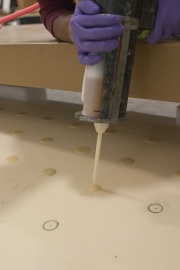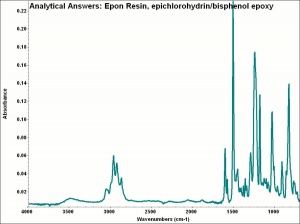Difference between revisions of "Epoxy"
| Line 12: | Line 12: | ||
Examples: Ablebond; Araldite [Huntsman ex Ciba-Geigy]; CM Bond; Epon® [Hexion]; Epotek; Hxtal; Phillyseal R (formerly Pliacre) [Philadelphia Resins]; UHU | Examples: Ablebond; Araldite [Huntsman ex Ciba-Geigy]; CM Bond; Epon® [Hexion]; Epotek; Hxtal; Phillyseal R (formerly Pliacre) [Philadelphia Resins]; UHU | ||
| + | == Applications == | ||
[[[SliderGallery rightalign|aaiEPON_epoxy.jpg~FTIR]]] | [[[SliderGallery rightalign|aaiEPON_epoxy.jpg~FTIR]]] | ||
| − | == | + | == Risks == |
| + | |||
| + | Hardeners are moderately toxic by ingestion, inhalation and skin contact. May form ammonia and hydrochloric acid upon degradation. | ||
| + | |||
| + | == Physical and Chemical Properties == | ||
Burns with yellow flame; smells of phenol. | Burns with yellow flame; smells of phenol. | ||
| Line 23: | Line 28: | ||
| 1.1-1.4 | | 1.1-1.4 | ||
|} | |} | ||
| − | |||
| − | |||
| − | |||
| − | |||
== Additional Information == | == Additional Information == | ||
| Line 39: | Line 40: | ||
[[media:download_file_275.pdf|General Characteristics of Polymers]] | [[media:download_file_275.pdf|General Characteristics of Polymers]] | ||
| − | |||
| − | |||
== Additional Images == | == Additional Images == | ||
Revision as of 16:32, 19 May 2020
Description
A series of thermosetting polymers based on the chemical reactivity of an epoxide group. Epoxies, first patented in Switzerland in 1939 by Pierre Castan, were further developed in the 1940s and 50s. They are composed of a liquid that, when mixed with a catalyst, crosslinks to form a hard, strongly bound solid. The most commonly used epoxies are made with epichlorohydrin reacted with bisphenol A. Epoxies are typically dense, insoluble structures that are dimensionally stable and wear resistant. Exhibitng minimal shrinkage with cure, they are used as adhesives, molded products, and baked enamel surface coatings. Some commercial brands that contain epoxies are: Ablebond, Araldite, Epon® resins, Epotek, Hxtal, Phillyseal R (formerly Pliacre) and UHU adhesives.
Synonyms and Related Terms
EP; epoxy resin; epoxide resin; polyepoxide; résine époxyde (Fr.); Epoxidharz (Deut.); resina epoxi (Esp.); poliepóxido (Esp., Port.); resina epossidica (It.); resina epoxídica (Port.); epoxi (Sven.)
Examples: Ablebond; Araldite [Huntsman ex Ciba-Geigy]; CM Bond; Epon® [Hexion]; Epotek; Hxtal; Phillyseal R (formerly Pliacre) [Philadelphia Resins]; UHU
Applications
Risks
Hardeners are moderately toxic by ingestion, inhalation and skin contact. May form ammonia and hydrochloric acid upon degradation.
Physical and Chemical Properties
Burns with yellow flame; smells of phenol.
| Density | 1.1-1.4 |
|---|
Additional Information
° J. Down, M.MacDonald, J.Te'treault, S.Williams, Adhesive Testing at the Canadian Conservation Institute-An Evaluation of Selected Poly(Vinyl acetate) and Acrylic Adhesives", Studies in Conservation 41:19-44, 1996.
° M.Savla, "Epoxy Resin Adhesives" in Handbook of Adhesives, I.Skeist (ed.), Van Nostrand Reinhold, New York, 1977, p.434-445.
Comparisons
Physical Properties for Selected Thermoset Resins
General Characteristics of Polymers
Additional Images
Sources Checked for Data in Record
- G.S.Brady, Materials Handbook, McGraw-Hill Book Co., New York, 1971
- Ralph Mayer, A Dictionary of Art Terms and Techniques, Harper and Row Publishers, New York, 1969 (also 1945 printing)
- Hoechst Celanese Corporation, Dictionary of Fiber & Textile Technology (older version called Man-made Fiber and Textile Dictionary, 1965), Hoechst Celanese Corporation, Charlotte NC, 1990
- Dictionary of Building Preservation, Ward Bucher, ed., John Wiley & Sons, Inc., New York City, 1996
- Wikipedia, the free encyclopedia, at http://www.wikipedia.com Comment: http://en.wikipedia.org/wiki/Epoxy (Accessed Feb. 10, 2006)
- Matt Roberts, Don Etherington, Bookbinding and the Conservation of Books: a Dictionary of Descriptive Terminology, U.S. Government Printing Office, Washington DC, 1982
- Pam Hatchfield, Pollutants in the Museum Environment, Archetype Press, London, 2002
- Tom Rowland, Noel Riley, A-Z Guide to Cleaning, Conserving and Repairing Antiques, Constable and Co., Ltd., London, 1981
- Michael McCann, Artist Beware, Watson-Guptill Publications, New York City, 1979
- Jane Down, Maureen MacDonald, Jean Te'treault, Scott Williams, Adhesive testing at the Canadian Conservation Institute-An evaluation of selected poly(vinyl acetate) and acrylic adhesives., Studies in Conservation, 41, 19-44, 1996
- Website address 1 Comment: www.nswpmith.com.au/historyofplastics.html
- Theodore J. Reinhart, 'Glossary of Terms', Engineered Plastics, ASM International, 1988
- Art and Architecture Thesaurus Online, http://www.getty.edu/research/tools/vocabulary/aat/, J. Paul Getty Trust, Los Angeles, 2000





